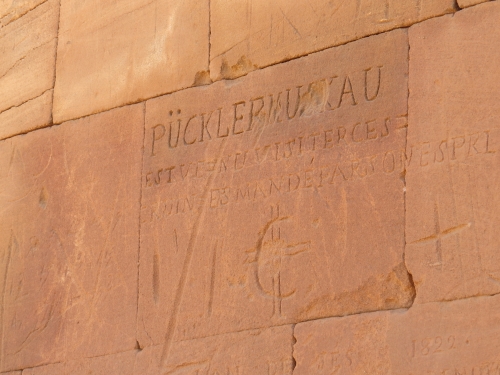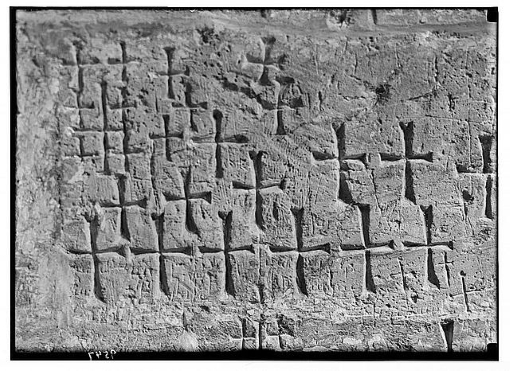Blog Connections
Historical Graffiti
One of the funniest Connections between WHS that we have on this website is Historical Graffiti. I always enjoy looking out for those pre-20th century scribblings while visiting a WHS. A good example was in the news this week: the discovery of more Roman graffiti at the site of the Written Rock of Gelt at Hadrian’s Wall. Roman soldiers working at the quarry had scratched a phallus into the wall, "a good luck symbol in Roman times".
The word 'graffiti' is of Italian origin and literally means 'little scratches or scribbles'. According to Chambers dictionary the exact English definition is: ”words or drawings, usually humorous, political or rude, scratched, sprayed or painted on walls, etc in public places”. The American Merriam Webster dictionary adds that they are “usually unauthorized”.
After cleaning up and adding some, we currently have 31 entries for this connection. Let’s have a closer look at what they are about:

How old are they?
Graffiti clearly is of all times. The writings or drawings can be as old as the site as itself, or as recent as the 19th century. The oldest ones among the WHS with Historical Graffiti are those at the Megalithic Temple of Hagar Qim (possibly 3rd millennium BC) and the ones at the Pyramids (an inscription has been confirmed as dating back to 1240 BC). During the 17th, 18th and 19th centuries it became almost commonplace to leave your markings on a classic archaeological site such as Persepolis and Baalbek.
Who made them?
The authors or ‘artists’ can be divided into several groups of people:
- Pilgrims / Crusaders
- Prisoners
- Mercenaries / Soldiers
- Workers
- Tourists
- Locals
They are mostly people who travelled from afar, wealthy ‘Victorian travellers’, explorers, pilgrims and to a certain extent soldiers that were sent abroad as well. Also people who got stuck somewhere and got bored, such as prisoners and (again) soldiers.
At certain places, the workers that constructed the WHS have left their mark also. This is possibly the case with the very early drawing at Hagar Qim: the model of a temple could have been left there by the builders. At the Pyramids, the various gangs of workers left inscriptions such as “Drunks of Menkaure” and “Friends of Khufu Gang” (Menkaure and Khufu being pyramid-building Egyptian kings) on bricks at the monuments of Giza. From a much later date is the graffiti left behind by the convicts who were assigned to construct Australia’s Great North Road.
A special case is that of the 15th century 'scientists' (a.k.a. catacomb hunters) who could not constrain themselves at Rome’s Catacombs, when they rediscovered earlier paintings. In some cases they just scribbled their names on top of the new findings!

What do they represent?
The most common form of historical graffiti is just the inscription of a person's name. Or “[name] was here”. Or “[name] [year]”. Sometimes this act of self-expression was extended to one or two full sentences, remarking on the quality of the location they just had visited.
While most graffiti are simple texts or drawings, more elaborate forms have been found as well. Tikal for example is covered with Mayan drawings of masks, animal figures and temples. In Pompei, more than 11,000 inscriptions have been found, ranging from poems to riddles.
Els - 3 March 2019
Comments
Jay T 30 March 2019
Just visited Maulbronn Monastery this week. The audio guide makes sure to point out the carved graffiti around the monastery from seminary students over the past centuries. Here’s a link to some photos I found showing the graffiti: https://www.norbertwoehnl.com/photos/maulbronn-monastery-germany-old-graffiti/
Paul Schofield 5 March 2019
Whoops - Athens I mean! - mixing my sources!
Paul Schofield 5 March 2019
The runic graffiti on the Piraeus Lion in venice (https://en.wikipedia.org/wiki/Piraeus_Lion) is doubly interesting in that it was made in another world heritage site, Istanbul.
Jay T 5 March 2019
So there is Westminster graffiti, then, even if in the abbey rather than the palace — great find, Els!
Els Slots 4 March 2019
I also added 3 more: Edinburgh Castle, Gebel Barkal and Aphrodisias. I guess almost all medieval castles and classical archaeological sites are possible candidates.
P.S.: found a source for Wartburg as well and added it
Ian Cade 4 March 2019
Good work on the Westminster one, Another one that may qualify and I’m always keen to recount is in the in the Houses of Parliament where there is a hidden plaque surreptitiously installed by Tony Benn to commemorate Emily Davidson’s rather impressive suffarage protest (well worth a further read https://www.parliament.uk/about/living-heritage/transformingsociety/electionsvoting/womenvote/case-studies-women-parliament/ewd/tony-benn-plaque/) I’m sure there are others around the place as well though there aren’t any desks in the Houses of Commons or Lords so perhaps not the same as in Washington.
Im trying to find something online about it, but at Wartburg there is graffiti left by Peter the Great in the room where Luther translated the bible. I will see if I can find something if not I will dig out my photo of it.
Els Slots 4 March 2019
Found something, Jay T: Coronation Chair in Westminster Abbey "Most of the graffiti on the back part of the Chair is the result of Westminster schoolboys and visitors carving their names in the 18th and 19th centuries. One of the tourists carved "P. Abbott slept in this chair 5-6 July 1800" on the seat."
Jay T 3 March 2019
Lawmakers have a tradition of carving their initials on their desks in the US (see https://www.politifact.com/tennessee/statements/2012/jul/18/julia-hurley/state-rep-julia-hruley-says-state-and-us-capitols-/). Is there any counterpart to this tradition in London’s Palace of Westminster? If so, that might be another addition to this link.
Els Slots 3 March 2019
Yes it was Prince Pückler himself, see https://www.worldheritagesite.org/connection/Prince+P%C3%BCckler
Dechmann Caspar 3 March 2019
Your picture is even better since the graffiti could be of the UNESCO-Duke of the Muskau park or at least a relative!